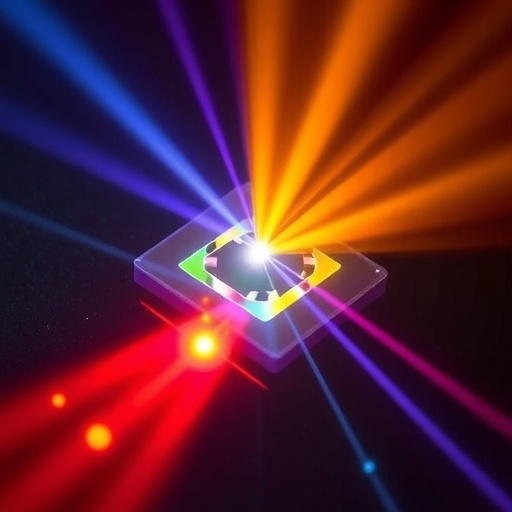In a groundbreaking development set to redefine the boundaries of photonic device engineering, researchers have unveiled a novel approach to tailor the emission characteristics of vertical-cavity surface-emitting lasers (VCSELs) by meticulously designing their cavity geometries. This advancement promises not only to enhance the versatility and efficiency of VCSELs but also to impact a broad spectrum of applications ranging from optical communication to sensing technologies.
VCSELs have long been celebrated for their compactness, low power consumption, and ease of integration with electronic components, making them essential components in modern optical systems. However, a persistent challenge has been the control over the beam shape, polarization, and emission profile, which traditionally relied heavily on external optical elements or complex fabrication techniques. The team led by Lu et al. addresses this by diving deep into the interplay between the cavity geometry and the optical modes within the laser itself.
The crux of this innovation lies in the precise engineering of the laser cavity’s internal structure — a region where photons are amplified before emission. By altering the geometric parameters of the cavity, such as its shape, size, and refractive index distribution, the researchers were able to manipulate the spatial distribution and phase of the emitted light directly. This cavity-centric approach allows for an intrinsic modification of the laser output, ensuring compactness and robustness without the need for external modulators.
One of the most striking outcomes of this research is the ability to shape the light in ways previously deemed difficult or unattainable with conventional VCSEL designs. For instance, by adopting non-standard, asymmetric cavity geometries, the researchers demonstrated that it is possible to generate highly directional beams or to produce emission profiles with specific polarization states. This control over directionality and polarization is crucial for applications in high-speed optical interconnects and quantum information processing, where beam quality and state purity dramatically influence overall system performance.
Furthermore, the study provides detailed insight into the underlying physics governing light-matter interactions within these uniquely designed cavities. By employing advanced numerical simulations alongside experimental validations, the research elucidates how cavity geometry affects the resonance modes, including their quality factors and spatial mode distributions. Such understanding lays a solid foundation for future explorations in photonic crystal lasers, microcavity resonators, and other nanophotonic platforms.
The experimental protocols crafted by the researchers involve state-of-the-art fabrication techniques capable of realizing complex three-dimensional cavity shapes at the microscale. This includes advanced lithography and etching methods that ensure the high fidelity of the designed geometries. The robustness of these fabrication strategies is crucial, as slight deviations can significantly impact the optical performance due to the sensitivity of resonance conditions to geometric perturbations.
An important aspect of the study is the versatility offered by this cavity geometry engineering approach. Unlike traditional methods that may focus on specific emission wavelengths or rely on separate components to achieve desired beam shaping, this paradigm shift enables in-situ control simply by geometry modifications. This adaptability could lead to rapid prototyping of customized laser sources tailored for niche applications, including biomedical imaging, precision metrology, and next-generation LiDAR systems.
Moreover, the potential improvements in laser efficiency are notable. By optimizing the cavity to favor certain modes that better overlap with the gain medium, the VCSELs can achieve lower threshold currents and enhanced slope efficiencies. This not only reduces power consumption but also improves thermal management, prolonging device lifespan and reliability — critical parameters for commercial viability in telecommunications and consumer electronics.
The authors also discuss the implications for scaling up production and integrating these advanced VCSELs into existing platforms. With the capability to engineer cavity geometries without compromising device footprint, these lasers can be seamlessly incorporated into photonic integrated circuits (PICs), paving the way for miniaturized optical systems capable of complex functions on-chip.
In addressing the fundamental limitations of beam quality and controllability inherent in current VCSEL designs, this research offers a transformative pathway. The geometric tailoring of cavities moves beyond conventional epitaxial growth constraints and opens the door to hybridizing material systems or introducing novel photonic elements inside the cavity itself, potentially expanding the operational wavelength range and modulation capacities.
The interdisciplinary approach taken by the researchers — combining theoretical physics, materials science, engineering, and applied optics — underscores the complexity and novelty of the work. It also sets a benchmark for future studies aiming to unlock the full potential of semiconductor lasers by embracing architectural innovations within the laser cavity.
Finally, the broad applicability of this cavity design philosophy extends well beyond VCSELs. The principles elucidated in this paper may inspire similar innovations in other types of micro- and nano-lasers, including quantum dot lasers, interband cascade lasers, and even emerging two-dimensional material-based photonic devices. This highlights the universal importance of geometric control in dictating light behavior at the microscale.
In summary, the control of vertical-cavity surface-emitting lasers through precise cavity geometry engineering presents a significant leap forward in photonics technology. By enabling direct shaping of the emitted light’s spatial and polarization characteristics from within the laser cavity, Lu and colleagues have set a precedent for more efficient, versatile, and compact laser sources. This advancement not only addresses longstanding challenges in laser physics but also holds transformative potential across a wide range of modern technologies reliant on coherent light.
Subject of Research: Tailoring emission properties of vertical-cavity surface-emitting lasers (VCSELs) through cavity geometry engineering.
Article Title: Shaping the light of VCSELs through cavity geometry design.
Article References:
Lu, H., Alkhazragi, O., Lin, H. et al. Shaping the light of VCSELs through cavity geometry design. Light Sci Appl 14, 344 (2025). https://doi.org/10.1038/s41377-025-01996-7
Image Credits: AI Generated




